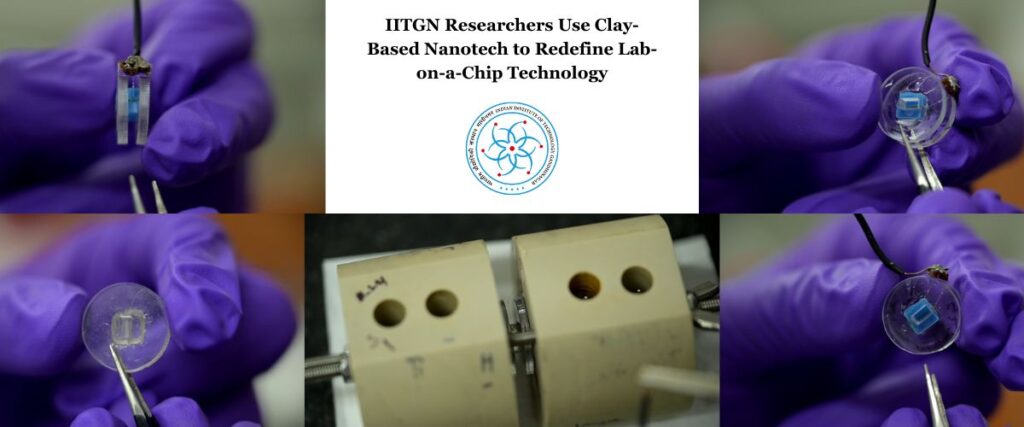- IITGN Researchers Use Clay-Based Nanotech to Redefine Lab-on-a-Chip Technology
- The team, in collaboration with researchers from Taiwan, Portugal, and the United States, have engineered ultra-thin vermiculite (clay) membranes to electrically control ions in salty environments.
- The nanofluidics breakthrough indicates how a naturally occurring mineral can act as an atomic-scale switch to guide ions as efficiently as biological membranes do.
- The research bridges the domains of biology, materials science, and electronics, paving the way to scalable, affordable, and sustainable technologies for water purification, power generation, and smarter diagnostics.
Gandhinagar: What if laboratories could detect diseases, test water purity, or power tiny sensors, and also fit on your fingertip? This is the promise of “lab-on-a-chip” technology, which includes compact devices that perform complex chemical or biological analyses using minuscule amounts of fluid. Despite four decades of research, the precise control of ion movement, the charged particles that drive the chemistry inside these chips, remains a challenge. In a recently published study in Nature Communications, researchers from the Indian Institute of Technology Gandhinagar (IITGN), in collaboration with teams from Taiwan, Portugal, and the United States, have demonstrated a breakthrough that could help overcome this hurdle.
They found a way to electrically control ion movement at the atomic scale using vermiculite clay, an abundant and naturally occurring mineral. This ability to guide and regulate ion movement is crucial for numerous scientific initiatives, from detecting biomarkers in a blood droplet to desalinating seawater. However, in high-salt environments, such as seawater or biological fluids (100 mM and higher), the ions become so densely packed that their electric fields dominate. As a result, applying an external voltage does little to steer their motion.
To regain control, the fluidic channels need to be extremely small, less than ten-billionths of a meter wide, so that the surfaces themselves dominate how ions move. But fabricating such tiny, stable, and uniform channels has long been a major technical challenge. Existing nanofluidic systems, typically made of graphene oxide or silicon, perform well only in very dilute conditions; under realistic, salty environments, their performance drops sharply. “We leveraged the layered atomic structure of vermiculite, which has tiny interlayer gaps that can trap ions and water molecules,” explained Professor Kalon, an Associate Professor in IITGN’s Department of Physics and the Principal Investigator of the study.

By carefully replacing the naturally present magnesium with potassium, calcium, or aluminium, the team was able to tune the gap between the sheets to just 3–5 angstroms, or a few ten-billionths of a meter. “At this ultra-confined scale, the electric fields from the negatively charged channel walls overlap across the entire space,’ he added. This allows electrical signals to influence all the ions passing through the channel, even in salty environments where this would usually be impossible.
Spurred by the success of this design, the team built a voltage-gated nanofluidic device, effectively a transistor that controls the flow of ions instead of electrons. “We tested the flow of potassium ions, which are crucial for many biological and chemical processes, through the vermiculite,” said Dr Biswabhusan Dhal, the first author of the study and a former PhD student at IITGN. By applying a small electrical signal, the team demonstrated an unprecedented level of control over the ion flow. They observed a massive 1400% change in electrical conductivity when switching the device on, a record for high-salt conditions.
Molecular dynamics simulations revealed how individual ions and water molecules moved inside the narrow spaces. In most systems, ions travel freely in water. But here, the narrowness of the channels forced ions to move in a single file, hopping from one site on the clay surface to another. This motion closely resembles the way ions pass through biological membranes in living cells, hinting at parallels between this engineered clay system and nature’s own nanochannels.
The implications of this interdisciplinary research surpass fundamental science. In water purification, such membranes could selectively remove harmful ions from industrial wastewater or seawater, offering a low-cost, sustainable alternative to current desalination methods. Lab-on-a-chip devices could become far more powerful, sensitive, and energy-efficient, especially for medical diagnostics. In energy technology, the same principles could help design better batteries, osmotic power generators, and iontronic sensors that mimic neural communication.
Building on their findings, the research team envisions studying ion interactions at even higher salt concentrations and under extreme confinement conditions. Understanding these interactions more deeply could help in designing next-generation nanofluidic systems capable of processing concentrated chemical or biological samples efficiently and with minimal energy use.
Complete list of authors:
Indian Institute of Technology Gandhinagar, India: Dr Biswabhusan Dhal, Naman Chandrakar, Aparna Rathi, Dr Suvigya Kaushik, and Prof Gopinadhan Kalon
University of Colorado Boulder, USA: Dr Yechan Noh
Indian Institute of Technology Bhubaneswar, India: Sanat Nalini Paltasingh and Prof Saroj Kumar Nayak
International Iberian Nanotechnology Laboratory, Portugal: Dr Siva Sankar Nemala & Dr Andrea Capasso
National Taiwan University of Science and Technology, Taiwan
Prof Li-Hsien Yeh
Explore more
🎤 Career – Real career stories and job profiles of life science professionals. Discover current opportunities for students and researchers.
💼 Jobs – The latest job openings and internship alerts across academia and industry.
🛠️ Services – Regulatory support, patent filing assistance, and career consulting services.




